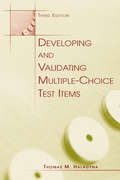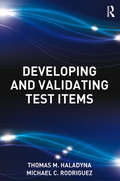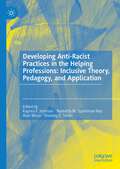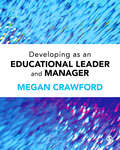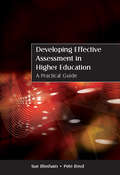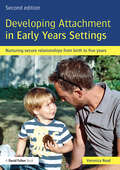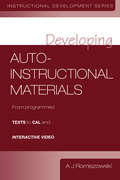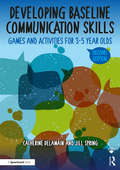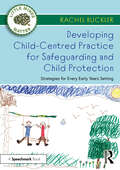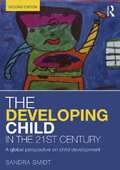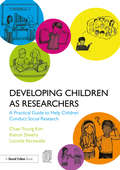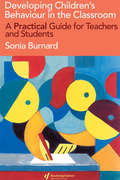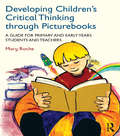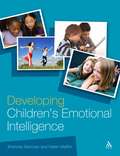- Table View
- List View
Developing and Validating Multiple-choice Test Items
by Thomas M. HaladynaThis book is intended for anyone who is seriously interested in designing and validating multiple-choice test items that measure understanding and the application of knowledge and skills to complex situations, such as critical thinking and problem solving. The most comprehensive and authoritative book in its field, this edition has been extensively
Developing and Validating Multiple-choice Test Items
by Thomas M. HaladynaThis book is intended for anyone who is seriously interested in designing and validating multiple-choice test items that measure understanding and the application of knowledge and skills to complex situations, such as critical thinking and problem solving. The most comprehensive and authoritative book in its field, this edition has been extensively
Developing and Validating Test Items
by Thomas M. Haladyna Michael C. RodriguezSince test items are the building blocks of any test, learning how to develop and validate test items has always been critical to the teaching-learning process. As they grow in importance and use, testing programs increasingly supplement the use of selected-response (multiple-choice) items with constructed-response formats. This trend is expected to continue. As a result, a new item writing book is needed, one that provides comprehensive coverage of both types of items and of the validity theory underlying them. This book is an outgrowth of the author’s previous book, Developing and Validating Multiple-Choice Test Items, 3e (Haladyna, 2004). That book achieved distinction as the leading source of guidance on creating and validating selected-response test items. Like its predecessor, the content of this new book is based on both an extensive review of the literature and on its author’s long experience in the testing field. It is very timely in this era of burgeoning testing programs, especially when these items are delivered in a computer-based environment. Key features include … Comprehensive and Flexible – No other book so thoroughly covers the field of test item development and its various applications. Focus on Validity – Validity, the most important consideration in testing, is stressed throughout and is based on the Standards for Educational and Psychological Testing, currently under revision by AERA, APA, and NCME Illustrative Examples – The book presents various selected and constructed response formats and uses many examples to illustrate correct and incorrect ways of writing items. Strategies for training item writers and developing large numbers of items using algorithms and other item-generating methods are also presented. Based on Theory and Research – A comprehensive review and synthesis of existing research runs throughout the book and complements the expertise of its authors.
Developing and Validating Test Items
by Thomas M. Haladyna Michael C. RodriguezSince test items are the building blocks of any test, learning how to develop and validate test items has always been critical to the teaching-learning process. As they grow in importance and use, testing programs increasingly supplement the use of selected-response (multiple-choice) items with constructed-response formats. This trend is expected to continue. As a result, a new item writing book is needed, one that provides comprehensive coverage of both types of items and of the validity theory underlying them. This book is an outgrowth of the author’s previous book, Developing and Validating Multiple-Choice Test Items, 3e (Haladyna, 2004). That book achieved distinction as the leading source of guidance on creating and validating selected-response test items. Like its predecessor, the content of this new book is based on both an extensive review of the literature and on its author’s long experience in the testing field. It is very timely in this era of burgeoning testing programs, especially when these items are delivered in a computer-based environment. Key features include … Comprehensive and Flexible – No other book so thoroughly covers the field of test item development and its various applications. Focus on Validity – Validity, the most important consideration in testing, is stressed throughout and is based on the Standards for Educational and Psychological Testing, currently under revision by AERA, APA, and NCME Illustrative Examples – The book presents various selected and constructed response formats and uses many examples to illustrate correct and incorrect ways of writing items. Strategies for training item writers and developing large numbers of items using algorithms and other item-generating methods are also presented. Based on Theory and Research – A comprehensive review and synthesis of existing research runs throughout the book and complements the expertise of its authors.
Developing Anti-Racist Practices in the Helping Professions: Inclusive Theory, Pedagogy, and Application
by Kaprea F. Johnson Narketta M. Sparkman-Key Alan Meca Shuntay Z. TarverThis book provides an interdisciplinary structure to critique existing approaches that have failed to eradicate systemic inequalities across helping professions. This timely contribution offers helping professionals sought after resources that many are clamoring for to improve their practice, their pedagogical stance, and their knowledge as it relates to antiracism and antiracist approaches. This collection of chapters that cover antiracist research, theory and practice approaches is in direct response to Kendi’s (2019) call to action to examine and revise institutional policies and practices to become antiracist. Collectively this book advances existing research and resources by providing interdisciplinary strategies for helping professionals to engage in antiracism through critical evaluation of research, practice, and policies. Doing so empowers helping professionals across disciplines to employ antiracist strategies that deconstruct and dismantle racism embedded within the foundational origins, professional standards, and disciplinary practices of helping professions while simultaneously merging research, practice, and advocacy that employs antiracist practices.
Developing as an Educational Leader and Manager
by Megan Crawford'This book is refreshing and distinctive. It takes the individual as the starting-point and builds outwards from there, to the vital but often neglected interpersonal dimension and the turbulent contexts of modern education. Vignettes help to make the theory concrete and activities bring the reader right into the frame.' - Ron Glatter, Emeritus Professor of Educational Administration and Management, The Open University and Hon. President of BELMAS Effective leadership combines organisational skills and personal qualities. Building on notions of leadership at all levels, this book contains an invaluable bank of creative ideas to help teachers already in management positions, as well as those just starting out, to reflect on their personal and leadership development. With a focus on organisational improvement and leading strategically within changing policy contexts, chapters interrogate key leadership issues such as managing people, values and context. Examples from the UK and internationally further demonstrate how to develop as a successful and sustainable leader. Content includes: · the influence of local and national contexts; · accountability; · working with stakeholders across boundaries and borders; · approaches to change; · becoming a strategic leader; · the educational leader as researcher. This is an essential resource for practising and aspiring educational leaders and managers and students on postgraduate or personal development courses, in the UK and internationally.
Developing as an Educational Leader and Manager (PDF)
by Megan Crawford'This book is refreshing and distinctive. It takes the individual as the starting-point and builds outwards from there, to the vital but often neglected interpersonal dimension and the turbulent contexts of modern education. Vignettes help to make the theory concrete and activities bring the reader right into the frame.' - Ron Glatter, Emeritus Professor of Educational Administration and Management, The Open University and Hon. President of BELMAS Effective leadership combines organisational skills and personal qualities. Building on notions of leadership at all levels, this book contains an invaluable bank of creative ideas to help teachers already in management positions, as well as those just starting out, to reflect on their personal and leadership development. With a focus on organisational improvement and leading strategically within changing policy contexts, chapters interrogate key leadership issues such as managing people, values and context. Examples from the UK and internationally further demonstrate how to develop as a successful and sustainable leader. Content includes: · the influence of local and national contexts; · accountability; · working with stakeholders across boundaries and borders; · approaches to change; · becoming a strategic leader; · the educational leader as researcher. This is an essential resource for practising and aspiring educational leaders and managers and students on postgraduate or personal development courses, in the UK and internationally.
Developing Assessment in Higher Education: A Practical Guide (UK Higher Education OUP Humanities & Social Sciences Higher Education OUP)
by Sue Bloxham Pete Boyd"As an overview, Developing Effective Assessment in Higher Education makes a very useful contribution to assessment literature, providing a publication that is relevant and accessible to practitioners whilst giving rigorous exploration of issues associated with student assessment. It should find a readership on that basis and will be welcomed as a considered and insightful contribution to the literature on student assessment." Higher Education Review What are the main issues when considering the design and management of effective assessment strategies for academic programmes? How should lecturers design and use assessment in university so that it helps students to learn, as well as judging their achievement? How can students be prepared for assessment, including peer, self and group assessment?This book provides comprehensive practical guidance on managing and improving assessment within higher education. It tackles all stages in the assessment cycle including: Assessment design Preparing students for assessment Marking and moderation Providing feedback Quality assuranceIt also provides a concise introduction to the research literature on assessment which will inform practice, debate, programme enhancement and practitioner research within university departments, teaching teams and courses for higher education teachers.The practical guidance in the book is substantiated with reference to relevant research and policy. In particular, it considers how the different purposes of assessment create conflicting demands for staff; often characterised by the tension between attempting to support student learning whilst meeting imperatives for quality assurance and demonstrable maintenance of standards. Issues are debated using concrete examples and workable solutions are illustrated. Consideration is also given to the management of assessment as well as to how new technologies might be used to develop assessment methods and enhance student learning. Developing Effective Assessment in Higher Education is key reading for both new and experienced lecturers, programme leaders and academic developers, and will enhance their efforts to use assessment to improve students’ learning as well as to grade them fairly, reliably and efficiently.
Developing Attachment in Early Years Settings: Nurturing secure relationships from birth to five years
by Veronica ReadProviding an accessible introduction to attachment thinking, this practical book offers early years practitioners’ advice on translating attachment principles into practice in their settings. It clearly explains how knowledge about attachment theory underpins everyday practice and highlights the crucial role of secure attachments in young children’s learning and development. Developing Attachments in Early Years Settings examines the importance of emotional‚ ‘holding’ and the nurturing of individual relationships within group childcare. The book aims to help you make a real difference to young children’s sense of self and emotional security by being ‘tuned in’, available, responsive and consistent. With a strong focus on facilitating secure attachments from the beginning and guidance on how to observe young children effectively, this new edition has been thoroughly updated and revised to include: How to make a positive contribution to good practice for Government funded 2 year olds A new chapter on the Emotional Environment and the Developing Brain Expansion of material on the importance of the outdoors, as well as Nurture group practice Additional material about working in partnership with parents and developing positive relationships Each chapter includes a personal reflection exercise and a positive contribution to good practice section. With its accessible approach, this book is essential reading for both practitioners and students looking for guidance on how to nurture secondary attachment relationships in group care settings.
Developing Attachment in Early Years Settings: Nurturing secure relationships from birth to five years
by Veronica ReadProviding an accessible introduction to attachment thinking, this practical book offers early years practitioners’ advice on translating attachment principles into practice in their settings. It clearly explains how knowledge about attachment theory underpins everyday practice and highlights the crucial role of secure attachments in young children’s learning and development. Developing Attachments in Early Years Settings examines the importance of emotional‚ ‘holding’ and the nurturing of individual relationships within group childcare. The book aims to help you make a real difference to young children’s sense of self and emotional security by being ‘tuned in’, available, responsive and consistent. With a strong focus on facilitating secure attachments from the beginning and guidance on how to observe young children effectively, this new edition has been thoroughly updated and revised to include: How to make a positive contribution to good practice for Government funded 2 year olds A new chapter on the Emotional Environment and the Developing Brain Expansion of material on the importance of the outdoors, as well as Nurture group practice Additional material about working in partnership with parents and developing positive relationships Each chapter includes a personal reflection exercise and a positive contribution to good practice section. With its accessible approach, this book is essential reading for both practitioners and students looking for guidance on how to nurture secondary attachment relationships in group care settings.
Developing Auto-instructional Materials
by Romiszowski, A.J.First Published in 1987. Routledge is an imprint of Taylor & Francis, an informa company.
Developing Auto-instructional Materials
by Romiszowski, A.J.First Published in 1987. Routledge is an imprint of Taylor & Francis, an informa company.
Developing Baseline Communication Skills: Games and Activities for 3-5 year olds (The Good Communication Pathway)
by Catherine Delamain Jill SpringDeveloping Baseline Communication Skills is a practical resource designed to fit with baseline assessments in primary school. The second edition of this bestselling resource contains a programme of games and activities to foster personal and social development, and promote language and literacy skills in 3–5 year olds. The book seeks to address language and communication difficulties for children coming into reception class by providing a range of fun and engaging activities. Suitable for whole classes or small groups of children, the activities focus on both personal, social, emotional development as well as language and literacy in areas such as body language, independence, turn taking, listening, speaking and auditory memory. Features include: 200 games and activities which are differentiated for different ages and levels of ability; A clear aim, equipment list and instructions for each activity; Photocopiable templates for ease of use; Supplementary resource sheets including pictures and scripts to use with the activities. Now fully revised and updated in line with current policy and legislation, this book is suitable for young children in any school setting including nurseries, playgroups and reception classes. It also includes material that may be used as an effective part of a speech and language therapy programme in consultation with a therapist. This is a unique manual that will be an essential addition to the materials used by professionals working with young children.
Developing Baseline Communication Skills: Games and Activities for 3-5 year olds (The Good Communication Pathway)
by Catherine Delamain Jill SpringDeveloping Baseline Communication Skills is a practical resource designed to fit with baseline assessments in primary school. The second edition of this bestselling resource contains a programme of games and activities to foster personal and social development, and promote language and literacy skills in 3–5 year olds. The book seeks to address language and communication difficulties for children coming into reception class by providing a range of fun and engaging activities. Suitable for whole classes or small groups of children, the activities focus on both personal, social, emotional development as well as language and literacy in areas such as body language, independence, turn taking, listening, speaking and auditory memory. Features include: 200 games and activities which are differentiated for different ages and levels of ability; A clear aim, equipment list and instructions for each activity; Photocopiable templates for ease of use; Supplementary resource sheets including pictures and scripts to use with the activities. Now fully revised and updated in line with current policy and legislation, this book is suitable for young children in any school setting including nurseries, playgroups and reception classes. It also includes material that may be used as an effective part of a speech and language therapy programme in consultation with a therapist. This is a unique manual that will be an essential addition to the materials used by professionals working with young children.
Developing Child-Centred Practice for Safeguarding and Child Protection: Strategies for Every Early Years Setting (Little Minds Matter)
by Rachel BucklerPlacing children at the centre of safeguarding principles and practices is vital for ensuring the best child protection. This essential resource provides early years practitioners with all that they need to be confident and competent as they fulfil their roles and obligations to safeguard and protect children. Exploring the main factors that impact on the lives of young children in the current safeguarding climate, this book is a starting point for understanding the risks and categories of abuse and neglect. Grounded in best practice, it gives practitioners encouragement and advice to help shape and drive practice forward with child-centred motives, practices and perspectives. The book offers: Insights into the current safeguarding climate backed by practical examples. An introduction to managing the different safeguarding challenges faced by early years professionals. Methods for contextualising these for children in the early years. Guidance on supporting vulnerable children, their families and other agencies working alongside them. Reflections, case studies and a wide range of example scenarios. Voices and insights from across the sector woven throughout for a holistic understanding of safeguarding. With accessible chapters drawing on best practice from across the sector at every level, this is a valuable resource for all those working in the early years, whether just starting out or highly experienced in the field.
Developing Child-Centred Practice for Safeguarding and Child Protection: Strategies for Every Early Years Setting (Little Minds Matter)
by Rachel BucklerPlacing children at the centre of safeguarding principles and practices is vital for ensuring the best child protection. This essential resource provides early years practitioners with all that they need to be confident and competent as they fulfil their roles and obligations to safeguard and protect children. Exploring the main factors that impact on the lives of young children in the current safeguarding climate, this book is a starting point for understanding the risks and categories of abuse and neglect. Grounded in best practice, it gives practitioners encouragement and advice to help shape and drive practice forward with child-centred motives, practices and perspectives. The book offers: Insights into the current safeguarding climate backed by practical examples. An introduction to managing the different safeguarding challenges faced by early years professionals. Methods for contextualising these for children in the early years. Guidance on supporting vulnerable children, their families and other agencies working alongside them. Reflections, case studies and a wide range of example scenarios. Voices and insights from across the sector woven throughout for a holistic understanding of safeguarding. With accessible chapters drawing on best practice from across the sector at every level, this is a valuable resource for all those working in the early years, whether just starting out or highly experienced in the field.
The Developing Child in the 21st Century: A global perspective on child development
by Sandra SmidtOffering a sociocultural approach to education and learning, this fascinating exploration of childhood provides an in-depth understanding of how children make sense of the world and the people in it. Examining the ways in which children express their thoughts, feelings and actively generate meaning through experience and interaction, this fully revised and updated new edition is illustrated throughout by extensive case studies and covers a diverse range of topics, including: socio-historical and global child development over time and place; the child as meaning-maker and active learner; learning in the context of family, culture, group, society; representing and re-representing the world; understanding roles, identity, race and gender; making sense of science and technology; the implications of neuroscience. Taking a clearly articulated and engaging perspective, Sandra Smidt draws upon multiple sources and ideas to illustrate many of the facets of the developing child in a contemporary context. She depicts children as symbol users, role-players, investigators and creative thinkers, and follows children's?progress in forming their understanding of their environment, asking questions about it, and expressing it through music, dance, art and constructive play. Highly accessible, and with points for reflection concluding each chapter, The Developing Child is essential reading for teachers, lecturers and students taking courses in early childhood, psychology or sociology.
The Developing Child in the 21st Century: A global perspective on child development
by Sandra SmidtOffering a sociocultural approach to education and learning, this fascinating exploration of childhood provides an in-depth understanding of how children make sense of the world and the people in it. Examining the ways in which children express their thoughts, feelings and actively generate meaning through experience and interaction, this fully revised and updated new edition is illustrated throughout by extensive case studies and covers a diverse range of topics, including: socio-historical and global child development over time and place; the child as meaning-maker and active learner; learning in the context of family, culture, group, society; representing and re-representing the world; understanding roles, identity, race and gender; making sense of science and technology; the implications of neuroscience. Taking a clearly articulated and engaging perspective, Sandra Smidt draws upon multiple sources and ideas to illustrate many of the facets of the developing child in a contemporary context. She depicts children as symbol users, role-players, investigators and creative thinkers, and follows children's?progress in forming their understanding of their environment, asking questions about it, and expressing it through music, dance, art and constructive play. Highly accessible, and with points for reflection concluding each chapter, The Developing Child is essential reading for teachers, lecturers and students taking courses in early childhood, psychology or sociology.
Developing Children as Researchers: A Practical Guide to Help Children Conduct Social Research
by Chae-Young Kim Kieron Sheehy Lucinda KerawallaEncouraging young children to create and carry out their own social research projects can have significant social and educational benefits. In addition, their research may help them to influence local and national policies and practices on issues that matter to them. To support this, Developing Children as Researchers acts as a practical guide to give teachers – and other adults who work with children – a set of structured, easy-to-follow session plans that will help children to become researchers in their own right. Comprising of ten session plans that have already been tried and tested in schools, this guide will assist you in supporting child researchers while helping you to develop the techniques for teaching research skills effectively. The session plans also ensure that children’s views are heard and reflected by encouraging their active curiosity and investigation of issues that they may be concerned about. Forming a step-by-step guide, the ten sessions cover themes such as: starting the research process and identifying a research topic; the three key principles of research: be sceptical, systematic and ethical; choosing research participants and drawing up a research plan; the range of data collection and analysis methods; reporting the results of, and reflecting upon, a research project. Children’s research has often depended upon the support of academic researchers to provide resources and training. By making the research training and facilitation process more widely accessible, this guide will help remove the psychological and practical hurdles that teachers and others who regularly work with children might feel about helping children’s research themselves.
Developing Children as Researchers: A Practical Guide to Help Children Conduct Social Research
by Chae-Young Kim Kieron Sheehy Lucinda KerawallaEncouraging young children to create and carry out their own social research projects can have significant social and educational benefits. In addition, their research may help them to influence local and national policies and practices on issues that matter to them. To support this, Developing Children as Researchers acts as a practical guide to give teachers – and other adults who work with children – a set of structured, easy-to-follow session plans that will help children to become researchers in their own right. Comprising of ten session plans that have already been tried and tested in schools, this guide will assist you in supporting child researchers while helping you to develop the techniques for teaching research skills effectively. The session plans also ensure that children’s views are heard and reflected by encouraging their active curiosity and investigation of issues that they may be concerned about. Forming a step-by-step guide, the ten sessions cover themes such as: starting the research process and identifying a research topic; the three key principles of research: be sceptical, systematic and ethical; choosing research participants and drawing up a research plan; the range of data collection and analysis methods; reporting the results of, and reflecting upon, a research project. Children’s research has often depended upon the support of academic researchers to provide resources and training. By making the research training and facilitation process more widely accessible, this guide will help remove the psychological and practical hurdles that teachers and others who regularly work with children might feel about helping children’s research themselves.
Developing Children's Behaviour in the Classroom: A Practical Guide For Teachers And Students
by Sonia BurnardThe authors of this text suggest that teachers need to be able to cope with pupil behaviour before thay can even begin to deliver the National Curriculum. Often classes contain both statemented children those offcially recognize as having behavioural problems and unstatemented but difficult children. Teachers have few strategies to deal with the kind of behaviour that these children present as little, if any, of their training is allotted to classroom and child management.; The authors aim to raise awareness of behavioural needs in the classroom and avoid exclusions. They do this by encouraging school staff to work together to develop policies which will encourage good behaviour.
Developing Children's Behaviour in the Classroom: A Practical Guide For Teachers And Students
by Sonia BurnardThe authors of this text suggest that teachers need to be able to cope with pupil behaviour before thay can even begin to deliver the National Curriculum. Often classes contain both statemented children those offcially recognize as having behavioural problems and unstatemented but difficult children. Teachers have few strategies to deal with the kind of behaviour that these children present as little, if any, of their training is allotted to classroom and child management.; The authors aim to raise awareness of behavioural needs in the classroom and avoid exclusions. They do this by encouraging school staff to work together to develop policies which will encourage good behaviour.
Developing Children’s Critical Thinking through Picturebooks: A guide for primary and early years students and teachers
by Mary RocheThis accessible text will show students and class teachers how they can enable their pupils to become critical thinkers through the medium of picturebooks. By introducing children to the notion of making-meaning together through thinking and discussion, Roche focuses on carefully chosen picturebooks as a stimulus for discussion, and shows how they can constitute an accessible, multimodal resource for adding to literacy skills, while at the same time developing in pupils a far wider range of literary understanding. By allowing time for thinking about and digesting the pictures as well as the text, and then engaging pupils in classroom discussion, this book highlights a powerful means of developing children’s oral language ability, critical thinking, and visual literacy, while also acting as a rich resource for developing children’s literary understanding. Throughout, Roche provides rich data and examples from real classroom practice. This book also provides an overview of recent international research on doing ‘interactive read alouds’, on what critical literacy means, on what critical thinking means and on picturebooks themselves. Lecturers on teacher education courses for early years or primary levels, classroom teachers, pre-service education students, and all those interested in promoting critical engagement and dialogue about literature will find this an engaging and very insightful text.
Developing Children’s Critical Thinking through Picturebooks: A guide for primary and early years students and teachers
by Mary RocheThis accessible text will show students and class teachers how they can enable their pupils to become critical thinkers through the medium of picturebooks. By introducing children to the notion of making-meaning together through thinking and discussion, Roche focuses on carefully chosen picturebooks as a stimulus for discussion, and shows how they can constitute an accessible, multimodal resource for adding to literacy skills, while at the same time developing in pupils a far wider range of literary understanding. By allowing time for thinking about and digesting the pictures as well as the text, and then engaging pupils in classroom discussion, this book highlights a powerful means of developing children’s oral language ability, critical thinking, and visual literacy, while also acting as a rich resource for developing children’s literary understanding. Throughout, Roche provides rich data and examples from real classroom practice. This book also provides an overview of recent international research on doing ‘interactive read alouds’, on what critical literacy means, on what critical thinking means and on picturebooks themselves. Lecturers on teacher education courses for early years or primary levels, classroom teachers, pre-service education students, and all those interested in promoting critical engagement and dialogue about literature will find this an engaging and very insightful text.
Developing Children's Emotional Intelligence
by Shahnaz Bahman Helen MaffiniToday's world presents children with a wide-range of challenges that can hinder their personal and academic development. It is essential, therefore that as educators we equip children with the knowledge and skills they need to be successful not just academically but also in life.Although there is a real pressure for schools to meet academic standards it is possible for practitioners to stimulate emotional growth through everyday classroom activities. By carefully planning a curriculum that encourages children to explore their feelings through imaginative media and make-believe play, healthy emotional growth can occur.The authors of this timely book provide a wealth of practical tools and techniques that you can use with your children to successfully develop their emotional intelligence.
